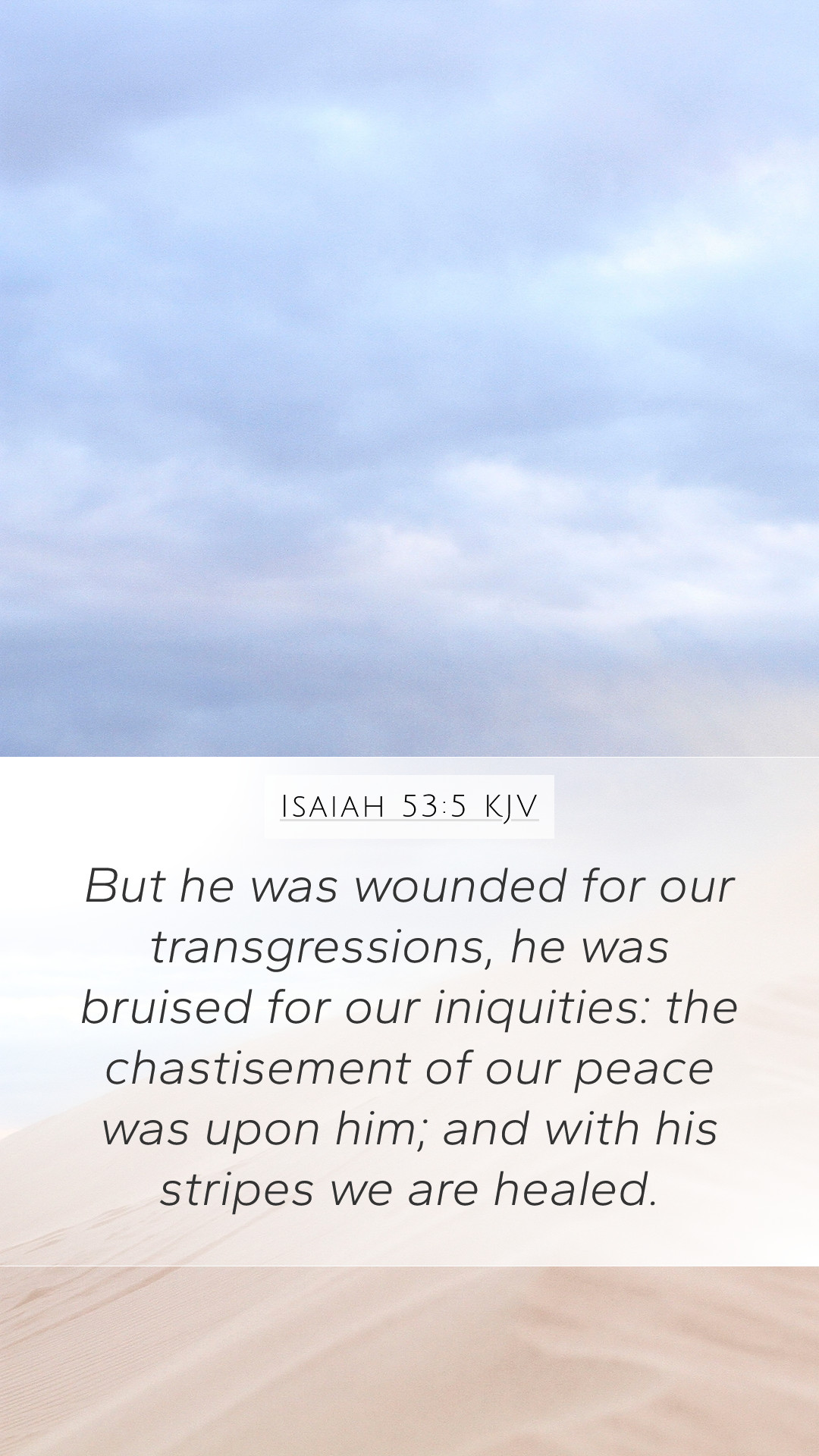Understanding Isaiah 53:5
Isaiah 53:5 states: "But he was wounded for our transgressions, he was bruised for our iniquities: the chastisement of our peace was upon him; and with his stripes we are healed." This verse is pivotal in the context of Christian theology and is often cited in discussions surrounding the atonement and messianic prophecies.
Bible Verse Meanings
The meaning of Isaiah 53:5 encompasses profound theological implications concerning sin, suffering, and redemption. Public domain commentaries offer rich insights into the layers of meaning behind this verse:
- Matthew Henry: Henry emphasizes that the suffering servant, often interpreted as Jesus Christ, endured pain not for his own transgressions but for humanity's sins. He highlights the idea that Christ's sufferings were vicarious, meaning that He took our place, which reflects the core of the doctrine of atonement.
- Albert Barnes: Barnes elaborates on the suffering described in the verse, noting that "wounded" refers to the physical and spiritual afflictions borne by Christ. He connects this suffering to the healing of both spiritual and physical ailments, suggesting that the “stripes” symbolize the means of healing brought about through Christ's sacrifice.
- Adam Clarke: Clarke provides a more straightforward interpretation, pointing out that the "chastisement of our peace" indicates the punishment necessary for our reconciliation with God. He posits that Christ's atoning death makes possible the peace between God and sinners, illuminating the transformative power of His sacrifice.
Bible Verse Interpretations
This verse is viewed as a prophecy of the coming Messiah, which is pivotal for understanding Scripture. The interpretations highlight how the birth, life, and death of Jesus fulfill these ancient prophecies:
- Isaiah 53:5 is often interpreted messianically, indicating that Jesus is the fulfillment of Old Testament prophecies concerning a suffering servant who would take on the sins of the world.
- The significance of this verse is further explored in the New Testament, where various writers relate Christ’s experiences to the prophecies of Isaiah, positioning Jesus as the embodiment of these predictions.
Scripture Analysis
Analyzing Isaiah 53:5 requires an understanding of its historical context and literary structure:
- Historical Context: Isaiah prophesied during a time of intense turmoil in Israel, portraying a future hope through the lens of suffering. This section of Isaiah was meant to offer both judgment and hope.
- Literary Structure: The chapter is one of the "Servant Songs" in Isaiah, emphasizing the contrast between the servant's suffering and the eventual glorification, encapsulating the journey from pain to healing.
Bible Verse Explanations
This verse not only explains the nature of Christ’s suffering but also illustrates the mechanics of redemption. Through His suffering, believers receive healing and peace:
- The "wounds" symbolize the severity of the atonement needed for reconciliation. It underscores that peace with God comes at a significant cost.
- The phrase “by His stripes we are healed” is interpreted both in spiritual terms (healing from sin) and sometimes in physical healing, indicating a holistic approach to salvation.
In-Depth Analysis of Isaiah 53:5
For a more comprehensive understanding, one should consider the following:
- Connection to New Testament: Matthew 8:17 refers to this verse, indicating that Jesus' healing miracles fulfill the prophecy.
- Theological Significance: The implications of Isaiah 53:5 are vast in Christian theology, involving concepts of substitutionary atonement, grace, and redemption.
- Application in Daily Life: Understanding this verse invites believers to live in light of the sacrifice, emphasizing themes of forgiveness, healing, and peace in interpersonal relationships.
Bible Study Insights
For groups or individuals seeking Bible study resources, exploring Isaiah 53:5 can be particularly fruitful:
- Discussion topics might include the nature of Christ’s suffering and its impact on personal faith.
- Using online Bible study tools can help deepen one’s understanding of the intricacies of biblical languages and historical backgrounds.
Related Cross References
- 1 Peter 2:24: This verse parallels Isaiah 53:5, reinforcing the concept of spiritual healing through Christ’s suffering.
- Matthew 20:28: This passage highlights Jesus' mission to serve and give His life as a ransom for many, connecting back to Isaiah’s theme of substitution.
- John 3:16: The famous declaration of God's love is rooted in the sacrificial heart of the Gospel, aligning with the message in Isaiah 53:5.
Conclusion
Isaiah 53:5 serves as a cornerstone of Christian faith, illustrating the depth of Christ's atoning work and its implications for both individual peace and communal forgiveness. By engaging with this verse through various lenses—historical, theological, and practical—believers can gain a richer understanding of scripture and its application to daily life.


